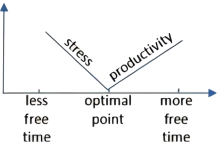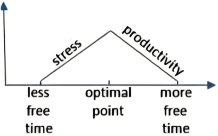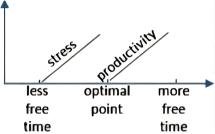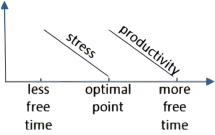Up and down the economic ladder, many Americans who work—and especially those raising kids—are pressed for time, wishing they had more of it to devote to leisure activities (or even just sleeping). At the same time, research has indicated that people who are busy tend to be happier than those who are idle, whether their busyness is purposeful or not.
A research paper released late last year investigated this trade-off, attempting to pinpoint (精确指出) how much leisure time is best. Its authors examined the relationship between the amount of “discretionary time” people had—basically, how much time people spend awake and doing what they want—and how pleased they were with their lives.
The paper, which analyzed data covering about 35,000 Americans, found that employed people’s ratings of their satisfaction with life peaked when they had in the neighborhood of two and a half hours of free time a day. For people who didn’t work, the optimal (最佳) amount was four hours and 45 minutes.
The research traced a correlation (关联) between free time and life satisfaction, but didn’t provide any definitive (最后的) insight into what underlies that correlation—“which is exciting, because this is a work in progress,” says Cassie Mogilner Holmes, a professor at UCLA’s Anderson School of Management and a co-author of the paper, which hasn’t yet been peer-reviewed or published in an academic journal.
An experiment that the researchers arranged hinted at (暗示) a possible explanation of the correlation they found. They asked participants to picture and describe what it would be like to have a certain amount of daily free time, and then report how they’d feel about that allotment (分配). “What we find is that having too little time makes people feel stressed, and maybe that’s obvious,” says Holmes. “But interestingly, that effect goes away—the role of stress goes away—once you approach the optimal point.” After that point, Holmes says, the subjects started to say they felt less productive overall, which could explain why having a lot of free time can feel like having too much free time.
It’s not clear what an individual is to do with these findings, since the amount of free time people have usually has something to do with a variety of factors, such as having children or a degree of control over work schedules. Holmes shared her research with the MBA students in her class on happiness, and some of the most time-crunched among them were comforted by the findings: “I think that two and a half hours creates a nice goal that even if you increase a little bit more of your discretionary time use, you can expect that it will translate into greater life satisfaction.”
1. According to the passage, what happens to Americans occupied with their work?| A.They allow themselves more leisure time. |
| B.They keep themselves busy on purpose. |
| C.They know how much leisure time is best. |
| D.They experience higher level of satisfaction. |
| A.Researchers have cast light on the cause of the correlation. |
| B.Unemployed people need more leisure time to feel content. |
| C.The paper on the correlation has achieved peer recognition. |
| D.Employed people enjoy more leisure time in the neighborhood. |
A. | B. |
C. | D. |
| A.Holmes is optimistic about the influence of her findings |
| B.individuals are encouraged to control their work schedules |
| C.people with tight schedules can’t benefit from the findings |
| D.the MBA students find no free time to obtain life satisfaction |
相似题推荐
【推荐1】Types of Social Groups
Life places us in a complex web of relationships with other people. Our humanness arises out of these relationships in the course of social interaction. Moreover, our humanness must be sustained through social interaction -- and fairly constantly so. When an association continues long enough for two people to become linked together by a relatively stable set of expectations, it is called a relationship.
People are bound within relationships by two types of bonds: expressive ties and instrumental ties. Expressive ties are social links formed when we emotionally invest ourselves in and commit ourselves to other people. Through association with people who are meaningful to us, we achieve a sense of security, love, acceptance, companionship, and personal worth. Instrumental ties are social links focused when we cooperate with other people to achieve some goal.
Occasionally, this may mean working with, instead of against, competitors. More often, we simply cooperate with others to reach some end without endowing the relationship with any larger significance.
Sociologists have built on the distinction between expressive and instrumental ties to distinguish between two types of groups: primary and secondary. A primary group involves two or more people who enjoy a direct, intimate, cohesive relationship with one another. Expressive ties predominate in primary groups: we view the people as ends in themselves and valuable in their own right. A secondary group entails two or more people who are involved in an impersonal relationship and have come together for a specific, practical purpose. Instrumental ties predominate in secondary groups ; we perceive people as means to ends rather than as ends in their own right. sometimes primary group relationships evolve out of secondary group relationships. This happens in many work settings. People on the job often develop close relationships with coworkers as they come to share gripes, jokes, gossip, and satisfactions.
A number of conditions enhance the likelihood that primary groups will arise. First, group size is important. We find it difficult to get to know people personally when they are milling about and dispersed in large groups. In small groups we have a better chance to initiate contact and establish rapport with them. Second, face - to - face contact allows us to size up others. Seeing and talking with one another in close physical proximity makes possible a subtle exchange of ideas and feelings. And third, the probability that we will develop primary group bonds increases as we have frequent and continuous contact. Our ties with people often deepen as we interact with them across time and gradually evolve interlocking habits and interests.
Primary groups are fundamental to us and to society. Sociologists view primary groups as bridges between individuals and the larger society because they transmit, mediate, and interpret a society’s cultural patterns and provide the sense of oneness so critical for social solidarity. Primary groups, then serve both as carriers of social norms and as enforcers of them.
1. According to Paragraph 1, which of the following statements is true of a relationship?| A.It is a structure of associations with many people. |
| B.It should be studied in the course of social interaction. |
| C.It places great demands on people. |
| D.It develops gradually over time. |
| A.Secondary group relationships begin by being primary group relationships. |
| B.A secondary group relationship that is highly visible quickly becomes a primary group relationship. |
| C.Sociologists believe that only primary group relationships are important to society. |
| D.Even in secondary groups, frequent communication serves to bring people into close relationships. |
| A.enlarge | B.evaluate |
| C.impress | D.accept |
| A.drawing comparisons between theory and practice |
| B.presenting two opposing theories |
| C.defining important concepts |
| D.discussing causes and their effects |
【推荐2】Regrets are often painful. A study suggests that some people can overcome them, said Jia Wei Zhang, a psychology graduate at the University of California. But this isn’t the case for everyone, he said.
The researchers wondered why some people report feeling improvement from regrets but others don’t. Does it lie in how people approach their regrets?
In the study, the researchers focused on self-compassion (自我同情) as a potential factor in why some people have an easier lime leaving their regrets behind them.
400 people attended an experiment. First, they were asked to write about their biggest regret. Half wrote something they did but wish they hadn’t done; the other half wrote something they didn’t do but wish they had. Then, the participants were randomly assigned to one of three groups: self compassion, self-esteem and a control group. The self-esteem group was asked to respond by “talking to yourself about this regret from the aspect of confirming your positive qualities”.
The control group was asked to write about their favorite hobby rather than their regret. Then, they were asked about their feelings of forgiveness, acceptance and personal improvement following the exercise.
They found that the self-compassion group reported greater feelings of acceptance, forgiveness and personal improvement, compared with the control group and the self esteem group. In other words, focusing on your best qualities is not what helps you feel better about a regret. Rather, being compassionate toward yourself is what may make a difference, the researchers found.
It’s possible that people who practice self-compassion are able to confront their regrets and see what went wrong, so they can make a better choice in the future, Zhang told Live Science. Self-compassion pushes people to accept their regret instead of running away from it.
The researchers used an example of this from a previous study on breast cancer patients who were asked to try thinking about their treatment in a positive light before it began. The women who did so reported greater feelings of personal growth later on.
1. What does the underlined word “confront” in Paragraph 7 mean?| A.Handle | B.Forget. |
| C.Ignore | D.Show. |
| A.Think of a way out. | B.Write about their regrets. |
| C.Record their favorite hobbies. | D.Treat their regrets in positive ways. |
| A.To cover up their regrets. |
| B.To see if they have weaknesses. |
| C.To see if they have self compassion. |
| D.To help them feel better about their regrets. |
| A.To show the method of the research. |
| B.To show the value of the acceptance. |
| C.To show the truth of people’s feeling. |
| D.To show the difficulty of the research. |
【推荐3】Babies are surrounded by human language, always listening and processing. Eventually, they put sounds together to produce a “Daddy” or a “Mama”. But what still confuses neuroscientists is exactly how the brain works to put it all together.
To figure it out, a team of researchers turned to a frequent stand-in (代替) for babies when it comes to language learning: the song-learning zebra finch. “We’ve known songbirds learn their song by first forming a memory of their father’s song or another adult’s song. Then they use that memory to guide their song learning,” said Neuroscientist Todd Roberts. “It’s been a long-term goal of the field to figure out how or where in the brain this memory is. This type of imitative learning that birds do is very similar to the type of learning that we engage in regularly—particularly when we’re young, we use it to guide our speech learning.”
Roberts and his team had a feeling that the interface (交叉区域) between sensory areas and motor areas in the brain was critical for this process, and they focused on a group of brain cells called the NIf.
“In order to prove that we could identify these circuits, we thought if we could implant a false memory.” First, they used a virus to cause the neurons (神经元) in the birds’ NIf to become sensitive to light. Then, using a tiny electrode as a flashlight, they activated (激活) the neurons. The length of each pulse of light corresponded with the amount of time the neurons would fire. And the birds’ brains interpreted that time period as the length of each note.
Soon enough, the birds began to practice the notes they had learned, even though they never really heard the sounds. Amazingly, the birds produced them in the correct social situations. The researchers say this is the first time anybody has found exactly a part of the brain necessary for generating the sorts of memories needed to copy sounds.
“This line of research is going to help us identify where in the brain we encode memories of relevant social experiences that we use to guide learning. We know that there are several neurodevelopmental disorders in people that have really far-reaching effects on this type of learning.”
1. The zebra finch is researched because its song-learning mode ________.| A.decides whether it will sing songs |
| B.helps it to say “Daddy” or “Mama” |
| C.is like the way babies learn speech |
| D.reflects its talent for imitating its father’s song |
| A.The interface in the brain. |
| B.Guidance from adults. |
| C.Imitative learning type like birds’. |
| D.The way of regular learning. |
| A.Scientists activated some neurons by using an electrode. |
| B.A bird only sings what it heard before. |
| C.The brain produces tiny electrodes. |
| D.Birds are sensitive to light. |
| A.A change in our way of listening and processing. |
| B.A chance to have relevant social experiences. |
| C.A better knowledge of the secrets of learning. |
| D.Identification of neurodevelopmental disorders. |
【推荐1】Babies are surrounded by human language, always listening and processing. Eventually, they put sounds together to produce a “Daddy” or a “Mama”. But what still confuses neuroscientists is exactly how the brain works to put it all together.
To figure it out, a team of researchers turned to a frequent stand-in (代替) for babies when it comes to language learning: the song-learning zebra finch. “We’ve known songbirds learn their song by first forming a memory of their father’s song or another adult’s song. Then they use that memory to guide their song learning,” said Neuroscientist Todd Roberts. “It’s been a long-term goal of the field to figure out how or where in the brain this memory is. This type of imitative learning that birds do is very similar to the type of learning that we engage in regularly—particularly when we’re young, we use it to guide our speech learning.”
Roberts and his team had a feeling that the interface (交叉区域) between sensory areas and motor areas in the brain was critical for this process, and they focused on a group of brain cells called the NIf.
“In order to prove that we could identify these circuits, we thought if we could implant a false memory.” First, they used a virus to cause the neurons (神经元) in the birds’ NIf to become sensitive to light. Then, using a tiny electrode as a flashlight, they activated (激活) the neurons. The length of each pulse of light corresponded with the amount of time the neurons would fire. And the birds’ brains interpreted that time period as the length of each note.
Soon enough, the birds began to practice the notes they had learned, even though they never really heard the sounds. Amazingly, the birds produced them in the correct social situations. The researchers say this is the first time anybody has found exactly a part of the brain necessary for generating the sorts of memories needed to copy sounds.
“This line of research is going to help us identify where in the brain we encode memories of relevant social experiences that we use to guide learning. We know that there are several neurodevelopmental disorders in people that have really far-reaching effects on this type of learning.”
1. The zebra finch is researched because its song-learning mode ________.| A.decides whether it will sing songs |
| B.helps it to say “Daddy” or “Mama” |
| C.is like the way babies learn speech |
| D.reflects its talent for imitating its father’s song |
| A.The interface in the brain. |
| B.Guidance from adults. |
| C.Imitative learning type like birds’. |
| D.The way of regular learning. |
| A.Scientists activated some neurons by using an electrode. |
| B.A bird only sings what it heard before. |
| C.The brain produces tiny electrodes. |
| D.Birds are sensitive to light. |
| A.A change in our way of listening and processing. |
| B.A chance to have relevant social experiences. |
| C.A better knowledge of the secrets of learning. |
| D.Identification of neurodevelopmental disorders. |
【推荐2】Children who don’t read proficiently by the end of third grade are far more likely to be left behind in many ways.
The first thing to know about early literacy is that it is critically important; the next, that it connects to a whole lot of other conditions and challenges. But the best thing to know is that there are solutions to the problem of poor reading skills and some smart people working toward them. They could use your help.
“It’s more than an education issue, more than a reading issue,” says Arianne Weldon, director of the Get Georgia Reading Campaign, a collaborative nonprofit founded in 2013. “Getting more kids to read takes more than good schools, more than great teachers, more than loving families. It really does take all of us working together.”
Only 42 percent of Georgia public school children are now reading proficiently by the end of third grade, according to 2019 Georgia Department of Education (DOE) figures — not a great number, but an improvement over the 37 percent recorded in 2015 and lower scores prior to that.
Weldon says children not in that proficiency group are four times more likely to drop out of high school and, further, that every student who doesn’t finish represents an estimated $260,000 in lost earnings and productivity.
“By the end of third grade,” says Mindy Binderman, executive director of Georgia Early Education Alliance for Ready Students, or GEEARS, a nonprofit concerned with early learning, “if children are not reading at grade level, they are less likely to be successful in school, less likely to graduate on time, more likely to engage in risky behavior. The third grade reading marker is such an important indicator of all that comes later and, frankly, all that came before.”
A key national study released by the Annie E. Casey Foundation in 2010 highlighted the reading problem, especially among students from low-income families and children of color; subsequent research has reinforced the correlation between poverty and both reading ability and failure to graduate from high school. Clearly, poverty plays a key role in children’s reading proficiency, influencing the schools they attend and the community resources they can utilize.
Parents’ education level, especially mothers’, is a factor as well. “Maternal education and maternal literacy is a huge predictor of child literacy and educational outcomes,” says Dana Rickman, vice president of the Georgia Partnership for Excellence in Education (GPEE), established by the Georgia Chamber and the Georgia Economic Developers Association to promote and support education. “We’ve got a pretty high adult illiteracy rate in Georgia that a lot of people don’t like talking about.” Improving adult literacy ultimately impacts children’s reading ability.
1. According to the passage, early literacy is important mainly because it ________.| A.indicate how well a child’s brain has been developing |
| B.explain the reasons why a child drops out of high school |
| C.tells whether a child may become successful as an adult |
| D.reports the average educational level of a certain region |
| A.Entering schools with fewer resources. |
| B.Achieving more poorly in high school. |
| C.Earning less than the ordinary people. |
| D.Causing more risks in future life. |
| A.improving mothers’ education is useful for bettering children’s reading ability |
| B.exposing children to reading tasks at an early age is part of family support |
| C.illiteracy rate can be greatly reduced by upgrading children’s communities |
| D.parents can predict their children’s early literacy based on their resources |
| A.Why third grade is seen bu experts as a critical period. |
| B.How the government may improve parents’ education level. |
| C.Why adult illiteracy rate is higher in Georgia than in other places. |
| D.How poverty may influence a child’s future academic development. |
【推荐3】How Did You Get Five Fingers?
Your arms and toes began as tiny buds that sprouted from your sides when you were just a four-week-old embryo (胚胎). By six weeks, these limb buds had grown longer and five rods of cartilage 软骨) had appeared in their flattened tips. By week seven, the cells between the rods had died away, forming five small fingers or toes from once-solid masses of flesh.
Now, a team of scientists led by James Sharpe from the Centre for Genomic Regulation in Barcelona has discovered that these events are carefully orchestrated by three molecules. They mark out zones in the embryonic hand where fingers will grow, and the spaces in between that are destined to die. Without such molecules, pianos and keyboards wouldn’t exist, and jazz hands would be jazz palms.
These three molecules work in a way first envisioned by Alan Turing, a legendary English mathematician and code-breaker. Back in 1952, Turing proposed a simple mathematical model in which two molecules could create patterns by spreading through tissues and interacting with each other. For example, the first molecule might activate the second, while the second blocks the first. Neither receives any guidance about where to go; through their dance, they spontaneously organize themselves into spots or stripes.
Since then, many scientists have found that these Turing mechanisms exist. They’re responsible for a cheetah’s spots and a zebrafish’s stripes. For 30 years, people have also suggested that they could sculpt our hands and feet, but no one had found the exact molecules involved.
Sharpe knew that these molecules would need to show a striped pattern. Sox9 seemed like the most promising candidate. It is activated in a striped pattern from a very early stage of development. By comparing cells where Sox9 is active or inactive, Jelena Raspopovic and Luciano Marcon found two other groups of genes—Bmp and Wnt—also formed striped patterns. Bmp rises and falls in step with Sox9 and both are active in the digits. Wnt is out of phase; it’s active in the gaps. The three molecules also affect each other: Bmp activates Sox9 while Wnt blocks it; and Sox9 blocks both of its partners. It looked like these were the molecules the team was searching for not a pair, as Turing suggested, but a trinity. To confirm this, they created a simulation of a growing limb bud and showed that Sox9, Bmp and Wnt could organize themselves into a pattern of five stripes, by activating and blocking each other.
There’s still a lot to discover, though. For example, I’ve used Bmp and Wnt as shorthands here—in reality, each represents a class of several molecules, and the team still needs to work out which specific member is part of the Turing’s proposal.
1. The underlined sentence in the second paragraph means that ________.| A.some certain molecules are necessary for the growth of human fingers |
| B.the development of embryos is dependent on some certain molecules |
| C.without some certain molecules, music won’t exist in this world |
| D.the molecules work in a way that Alan Turing once offered |
| A.Molecules interact by following a strict mathematical model. |
| B.Molecules have a strong will to form patterns in nature. |
| C.The formation of patterns in nature may be dominated by molecules. |
| D.Alan Turing was able to track down the movement of molecules. |
| A.A protein that determines humans’ development in childhood. |
| B.A gene especially important for the development of our limbs. |
| C.A striped pattern that always interacts with Bmp and Wnt. |
| D.A simulation of growing limbs that activate and block each other. |
| A.How human limbs are developed may well be similar to how animal spots are shaped. |
| B.The way Sox9 interacts with Bmp and Wnt is still a mystery that needs further studying. |
| C.Sox9 can activate both Bmp and Wnt to form our limbs, according to scientific research. |
| D.Sox9, Bmp and Wnt are three specific molecules that determine the growth of fingers. |




